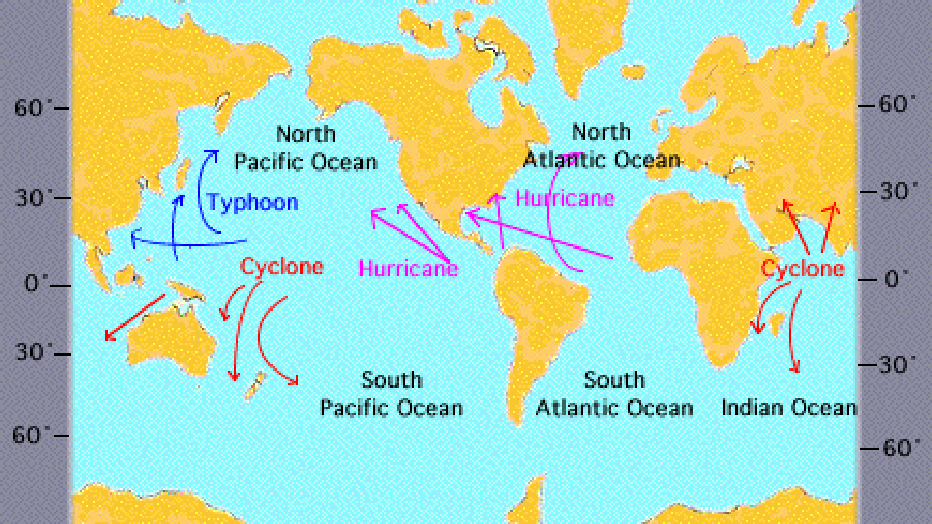Tropical triplets: hurricane, typhoon, and cyclone
Until Super Typhoon Haiyan (aka “Yolanda”) slammed the Philippines there were quite a few folks who had no idea what a typhoon is, much less a super typhoon. The different titles can be confusing, especially when combined with different names (ie: Haiyan and Yolanda for the same storm).
Like soda and pop, bubbler and water fountain, we have different names for the same things. It just depends on where you are. Typhoons, hurricanes, and cyclones are nearly the same thing. The only tricky one is cyclone. In most cases the full name is “tropical cyclone” while over water. The generic term “cyclone” can be used for lesser known, unnamed storms over land.
All three pertain to large (usually 300-600 miles across), rapidly rotating storms over the warmer waters of the ocean. These storms do not have warm and cold fronts like the storm systems we see on land.

Where hurricanes, typhoons, and cyclones are found.
When temps top around 80°, there is enough energy to feed a low pressure system helping it grow into a hurricane. Typhoons and cyclones only need a water temperature of about 27°, but that’s because those parts of the world use Celsius. In reality 80° F = 27° C.
The minimum winds speed to earn one of these titles is usually 74 mph. Though the breakdown of names actually grows to 5 different titles depending again on location:
- Hurricane for the Atlantic and Pacific Ocean near the U.S.
- Typhoon for the northwest Pacific Ocean
- Severe Tropical Cyclone parts of the Indian and southwestern Pacific Ocean
- Very Severe Cyclonic Storm in the north Indian Ocean
- Tropical Cyclone in the southwest Pacific Ocean
Top billing for a hurricane is a category 5. This title is achieved once wind speeds reach above 156 mph. Its counterpart, A super typhoon is born when winds speed reach above 150 mph.
While different names cover the same type of tropical storm system the numbers in which they appear are very different. Each year the average number of storms reaching hurricane status in the Atlantic is about 6-7. Hurricanes in the eastern Pacific 8-9. Cyclones in the Indian Ocean 10-11. Typhoons in the northwest Pacific 16-17.
While I mentioned all of these storms rotate at incredible speeds, the directing of their spin isn’t always the same. Tropical systems in the northern Hemisphere spin in a counter-clockwise direction. South of the equator the spin is clockwise.
The reversal of spin only pertains to very large, long lived rotations. As Bart learned the hard way on the Simpsons toilets in Australia can flush the same direction as toilets in America.
| Tropical Storm or stronger (greater than 17 m/s sustained winds) | Hurricane/Typhoon/Severe Tropical Cyclone (greater than 33 m/s sustained winds) | |||||
| Basin | Most | Least | Average | Most | Least | Average |
| Atlantic* | 28 | 4 | 12.1 | 15 | 2 | 6.4 |
| NE/Central Pacific |
28 | 8 | 16.6 | 16 | 3 | 8.9 |
| NW Pacific | 35 | 14 | 26.0 | 23 | 7 | 16.5 |
| N Indian | 10 | 2 | 4.8 | 5 | 0 | 1.5 |
| SW Indian | 14 | 4 | 9.3 | 8 | 1 | 5.0 |
| Aus SE Indian | 16 | 3 | 7.5 | 8 | 1 | 3.6 |
| Aus SW Pacific | 20 | 4 | 9.9 | 12 | 1 | 5.2 |
| Globally | 102 | 69 | 86.0 | 59 | 34 | 46.9 |

